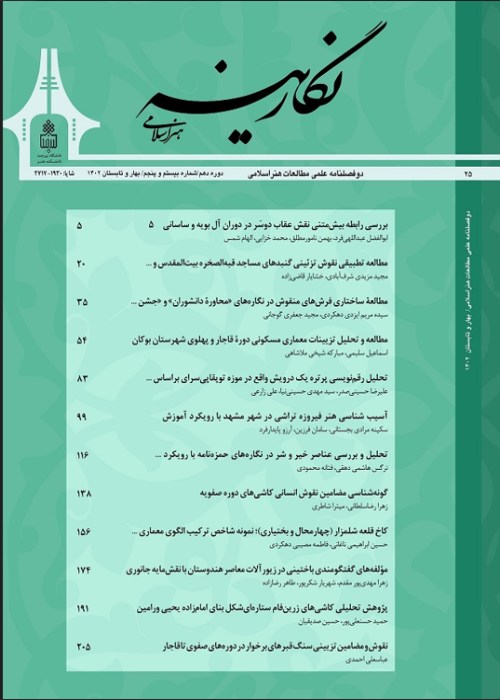Representation of sacred and mythical Islamic trees in Islamic painting(Zaqqum, Tuba, Sidrat Al-Muntaha)
The tree has a special sanctity and importance in the belief of Muslims and because of its many references to it in the Quran and Hadiths. One of these reasons is the presence of the tree in the creation of Adam and Eve and their involvement in their destiny. There has been a close connection between man and the tree since the beginning of creation. In mythological cultures and in various religions, sometimes mythical trees are combined with other creatures such as humans and animals, and a new tree is created with extraordinary appearance and abilities. Many concepts and metaphors of the tree have been expressed in the narrations and speech’s Islamic scholars. This research has been done to investigate different narrations of the descriptions of these religious-mythical trees and their correspondence with the existing miniatures. The questions raised are: What are the symbolic meanings of the trees of Zaqqum, Tuba and Sidrat-al-Muntaha in Muslim belief? Are the reflections of these concepts in the related painting appropriate to the descriptive texts? The tree in Islamic beliefs has conflicting symbolic meanings, evoking both the symbol of hell (the tree of Zaqqum) and the concept of paradise (the tree of Tuba and Sidrat al-Muntaha). These trees have been explained in the Quran and Hadiths with various descriptions. Contrary to what has been repeatedly depicted in Islamic painting, the depiction of these three extraordinary trees has rarely been done. The tree of Zaqqum is a symbol of hell and a means of punishing sinners and its place in the depths of hell. In contrast, Tuba and Sidrat al-Muntaha are allegories of paradise and its gifts that are in the heavens. This metaphor is precisely displayed in a number of drawings. This interpretation and analysis of the confrontation between these trees also applies to their location in the universe, as mentioned in the narrations, their position at the top and bottom of the universe is also depicted in the existing painting in the same way. On the other hand, the metaphorical opposition of trees to each other evokes the concept of duality and the opposition of "Good" and "Evil". Some narrators and sages consider the Tuba tree to be the same overturned tree described in mythological and cosmic cultures with its own abilities and characteristics. In some paintings, this tree is sanctified, decorated and accompanied by Quranic verses or the names of God and the names of the Prophet (PBUH), Imam Ali (AS) and his companions. Unlike other religious subjects that have been frequently seen and reproduced in painting, the depiction of these trees has been abused and rarely shown. In any case, it seems that in almost all cases, the images are in harmony with the descriptive texts and narratives of these trees, and the illustrator has been faithful to the texts and Hadiths. The research method used for this research is descriptive and somewhat analytical and the required information and data have been obtained through authoritative scientific books and websites.
- حق عضویت دریافتی صرف حمایت از نشریات عضو و نگهداری، تکمیل و توسعه مگیران میشود.
- پرداخت حق اشتراک و دانلود مقالات اجازه بازنشر آن در سایر رسانههای چاپی و دیجیتال را به کاربر نمیدهد.



